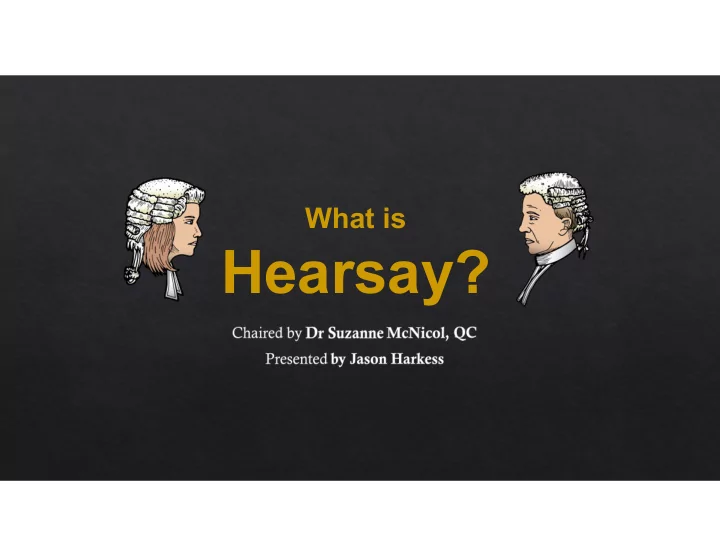

What is Hearsay?
Evidence Act 2008 — Section 59 The hearsay rule—exclusion of hearsay evidence (1) Evidence of a previous representation made by a person is not admissible to prove the existence of a fact that it can reasonably be supposed that the person intended to assert by the representation. (2) Such a fact is in this Part referred to as an asserted fact . (2A) For the purposes of determining under subsection (1) whether it can reasonably be supposed that the person intended to assert a particular fact by the representation, the court may have regard to the circumstances in which the representation was made. Note Subsection (2A) was inserted as a response to the decision of the Supreme Court of New South Wales in R v Hannes (2000) 158 FLR 359.
1. a previous representation Evidence Act 2008 — Section 59 The hearsay rule—exclusion of hearsay evidence 2. made by a person (1) Evidence of a previous representation made by a person is not admissible to prove the existence of a fact that it can reasonably be supposed that the person intended to assert by the representation. 3. containing an asserted fact (2) Such a fact is in this Part referred to as an asserted fact . 4. intended to be asserted by the (2A) For the purposes of determining under subsection (1) whether it can reasonably be supposed that the maker ( objectively determined) person intended to assert a particular fact by the representation, the court may have regard to the circumstances in which the representation was made. 5. adduced by a party to prove the Note Subsection (2A) was inserted as a response to the decision of the asserted fact Supreme Court of New South Wales in R v Hannes (2000) 158 FLR 359.
• Maker of previous representation must be human. • Not usually a contentious issue. • Obviously excludes animals. • Query whether it excludes computer generated statements.
• Express assertions are easy to decipher. • Implied assertions involve reading between then lines (e.g. Walton v R – “ Hello Daddy ”).
• Maker of previous representation must intend to assert fact. • What are her intentions right now? • Intention determined objectively • Intention not contentious in relation to express assertions. • Can implied assertions be unintended?
• Why is counsel adducing evidence? • How is it relevant ? • Is it relevant because it proves the asserted fact? If so, it’s hearsay . • Is it relevant for another purpose ? • Is it relevant for multiple purposes ?
• Why is counsel adducing evidence? • How is it relevant ? • Is it relevant because it proves the asserted fact? If so, it’s hearsay . • Is it relevant for another purpose ? • Is it relevant for multiple purposes ?
Don’t forget the exceptions! • Section 59 excludes the evidence being admitted for a hearsay purpose. • But consider whether an exception might apply (e.g. s 60, 62-67, 69, 81). • Is it relevant because it proves the asserted fact? If so, it’s hearsay . • Is it relevant for another purpose ? • Is it relevant for multiple purposes ?
Recommend
More recommend